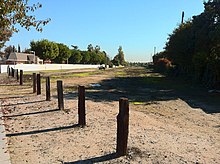Right-of-way
A right-of-way or the railway right of way and the railway, small railroad, mountain railway and waterway law describe, among other things, the right of the railway to drive over private property under certain conditions. It is a subgroup of the road and right of way and differs in Germany from the expropriation law .
Easement for transportation
Through the right-of-way or the railroad right of way and the railroad, light rail, mountain railway and waterway law, it is possible to move and operate a track, a canal or a similar transport facility over someone else's property, usually to and from another property. It is a type of easement (in Austria and Switzerland also Servitut, in the Anglo-American language area easement ) that is granted or reserved for transport purposes. It is a real right to use someone else's property for rail traffic, a car road, a public footpath or bicycle path, a canal, and for electrical transmission lines, oil and gas pipelines. The right is reserved for the maintenance or expansion of existing services. If the facility is abandoned it can be returned to the original owners.
United States
In the United States , railroad rights ( right-of-way , ROW, or R / O / W) are generally described by applicable state law as the private property of the relevant railroad company. Most US railroad companies have their own police force who can arrest and prosecute intruders who violate their rights of way. Some rail traffic rights now relate to cycling and hiking trails.
Designations of the railway right of way
The various designations of railroad law in the United States are as follows:
- Active is a railway line that is used regularly or even occasionally.
- A railway line for which the railway reserves the right to reactivate it is out of service or closed . The route can be out of service for decades. Therefore, tracks or level crossings that have since been removed must be replaced.
- In the event of an embargo , the tracks will be dismantled, but the rail traffic law will be retained and B. used by a hiking or cycling path or other similar use.
- The task ( English abandonment) is a lengthy formal process in which the railway company gives up all rights and obligations to the line. In most cases, the tracks are first removed and sold as scrap, and all level crossings are re-tarred. The route will then never be active again. The rights fall to the neighboring property owners.
Railway rights of way for uses other than rail transport
Railroad rights of way in the United States are not limited to rail transport and associated equipment. They are sometimes used to enable the laying of communications cables (such as fiber optic cables ) or natural gas pipelines , or to operate power transmission lines along a railroad.
Great Britain and northern Ireland
In the United Kingdom of Great Britain and Northern Ireland , railway companies receive the rights necessary for the construction and operation of the railway through a Private Act of Parliament .
Route
In a figurative sense, right-of-way also often describes the route of a railway line or another transport facility.
Individual evidence
- ↑ Railway right of way. In: Organization plan of the Federal Administrative Court.
- ↑ Railway, light rail, mountain railway and waterway law. In: Administrative Court Osnabrück: Competence of the chambers.
- ^ Henry Campbell Black: Right-of-way. In: A law dictionary containing definitions of the terms and phrases of American and English jurisprudence, ancient and modern: and including the principal terms of international, constitutional, ecclesiastical, and commercial law, and medical jurisprudence, with a collection of legal maxims…. West Publishing Co., 1910, p. 1040.
- ^ Dick Pool: Various designations of railroad right of way.


